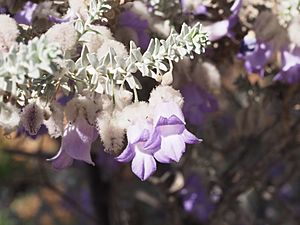Woolly-sepaled eremophila facts for kids
Quick facts for kids Woolly-sepaled eremophila |
|
|---|---|
 |
|
| Eremophila lachnocalyx leaves and flowers | |
| Scientific classification | |
| Genus: |
Eremophila (plant)
|
| Species: |
lachnocalyx
|
The Eremophila lachnocalyx, also known as the woolly-sepaled eremophila, is a type of flowering plant. It belongs to the figwort family, called Scrophulariaceae. This plant is special because it is only found in Western Australia. It grows as an upright, spreading bush with fuzzy, grayish leaves. Its most unique part is its very woolly sepals, which are like small leaves that protect the flower bud.
Contents
What Does This Plant Look Like?
The Eremophila lachnocalyx is an upright bush with many tangled branches. It can grow to be about 0.6–1.5 m (2–5 ft) tall. Its branches and leaves are covered in thick, woolly hairs, which makes them look grayish. The leaves grow close together, often in spirals around the branches. They are shaped like an ellipse or an egg, about 3.5–10 mm (0.1–0.4 in) long and 2.5–4 mm (0.1–0.2 in) wide. Sometimes, they can be covered in a sticky substance called resin, making them look smooth.
The flowers grow one by one where the leaves meet the stem. Each flower sits on a straight, hairy stalk that is about 8.5–16 mm (0.3–0.6 in) long. There are five thin, triangular sepals, usually 9–12.5 mm (0.4–0.5 in) long. The outside of these sepals is very woolly. The petals are 13–25 mm (0.5–1 in) long and are joined at the bottom to form a tube shape. The outside of this petal tube is lilac or deep violet, and the inside is white. The outside of the tube is mostly hairy, but the inside tips of the petals are smooth. The inside of the tube is woolly. There are four stamens (the parts that make pollen) hidden inside the petal tube. This plant usually blooms from June to September. After flowering, it produces oval-shaped fruits that are about 6–7 mm (0.2–0.3 in) long and have a hard, woolly covering.

How Was This Plant Named?
The Eremophila lachnocalyx was first officially described in 1942. A botanist named Charles Gardner gave it its scientific name. He published his description in a scientific journal called Journal of the Royal Society of Western Australia. The second part of its name, lachnocalyx, comes from Ancient Greek words. It means "woolly sepals," which perfectly describes its fuzzy flower parts!
Where Does This Plant Grow?
This type of eremophila plant likes to grow in red-brown clay soil. You can find it on flat areas or along places where water flows. It grows in different spots between Sandstone, the Barlee Range, and Karijini National Park. These areas are in the Gascoyne, Murchison, and Pilbara regions of Western Australia.
Is This Plant Endangered?
Good news! The Western Australian Government Department of Parks and Wildlife has classified this plant as "not threatened." This means it is not currently in danger of disappearing.
Growing This Plant in Gardens
The Eremophila lachnocalyx is a very pretty plant for gardens. Its silvery-gray leaves and many cottony buds, followed by pale lilac or purple flowers, make it one of the most attractive eremophilas. It can be a bit tricky to grow from cuttings (small pieces of the plant). Most plants grown in gardens have been grafted. This means a piece of Eremophila lachnocalyx is joined onto the rootstock (root system) of another plant, like Myoporum. It grows best in soil that drains well and needs lots of sunshine. It can handle dry conditions. It can also survive light frosts, but in cold, wet places, it might get fungal diseases.

